
(a)
Interpretation:
The shape, hybridization of the central atom, ideal and deviated bond angle in
Concept introduction:
Hybridization is the process of intermixing of atomic orbital of slightly different energies to form hybrid orbitals that have similar energy. These orbital have lower energy and more stability than the atomic orbital. Hybridization of the central atom can be determined from the number of electron groups around the central atom in the Lewis structure of the molecule. Single bond, double bond, triple bond and lone pair all are considered as single electron group.
The shape of the molecule is determined by the electron bond pairs and lone pairs that are present around the central atom. The angle between the two bonds is called the bond angle. It is determined by the hybridization of the central atom and the presence of lone pairs around it.
(a)
Answer to Problem 11.38P
In
Explanation of Solution
The Lewis structure of
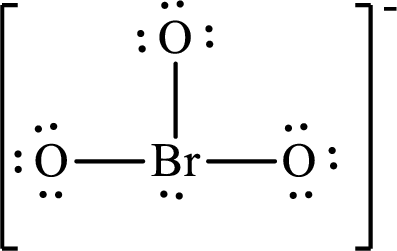
Boron forms three single bonds with three oxygen atoms and one lone pair is present on it so four hybrid orbitals are required and therefore the hybridization of boron in
The presence of lone pair on the central atom results in the deviation of bond angles from that of the ideal ones.
(b)
Interpretation:
The shape, hybridization of the central atom, ideal and deviated bond angle in
Concept introduction:
Hybridization is the process of intermixing of atomic orbital of slightly different energies to form hybrid orbitals that have similar energy. These orbital have lower energy and more stability than the atomic orbital. Hybridization of the central atom can be determined from the number of electron groups around the central atom in the Lewis structure of the molecule. Single bond, double bond, triple bond and lone pair all are considered as single electron group.
The shape of the molecule is determined by the electron bond pairs and lone pairs that are present around the central atom. The angle between the two bonds is called the bond angle. It is determined by the hybridization of the central atom and the presence of lone pairs around it.
(b)
Answer to Problem 11.38P
In
Explanation of Solution
The Lewis structure of
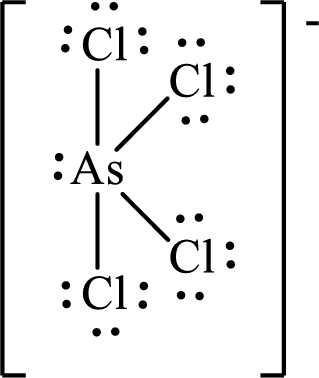
Arsenic forms four single bonds with four chlorine atoms and one lone pair is present on it so five hybrid orbitals are required and therefore the hybridization of arsenic in
The presence of lone pair on the central atom results in the deviation of bond angles from that of the ideal ones.
(c)
Interpretation:
The shape, hybridization of the central atom, ideal and deviated bond angle in
Concept introduction:
Hybridization is the process of intermixing of atomic orbital of slightly different energies to form hybrid orbitals that have similar energy. These orbital have lower energy and more stability than the atomic orbital. Hybridization of the central atom can be determined from the number of electron groups around the central atom in the Lewis structure of the molecule. Single bond, double bond, triple bond and lone pair all are considered as single electron group.
The shape of the molecule is determined by the electron bond pairs and lone pairs that are present around the central atom. The angle between the two bonds is called the bond angle. It is determined by the hybridization of the central atom and the presence of lone pairs around it.
(c)
Answer to Problem 11.38P
In
Explanation of Solution
The Lewis structure of

Selenium forms four single bonds with four oxygen atoms so four hybrid orbitals are required and therefore the hybridization of selenium in
The shape of the molecule is determined by the hybridization only if no lone pair is present on the central atom.
(d)
Interpretation:
The shape, hybridization of the central atom, ideal and deviated bond angle in
Concept introduction:
Hybridization is the process of intermixing of atomic orbital of slightly different energies to form hybrid orbitals that have similar energy. These orbital have lower energy and more stability than the atomic orbital. Hybridization of the central atom can be determined from the number of electron groups around the central atom in the Lewis structure of the molecule. Single bond, double bond, triple bond and lone pair all are considered as single electron group.
The shape of the molecule is determined by the electron bond pairs and lone pairs that are present around the central atom. The angle between the two bonds is called the bond angle. It is determined by the hybridization of the central atom and the presence of lone pairs around it.
(d)
Answer to Problem 11.38P
In
Explanation of Solution
The Lewis structure of
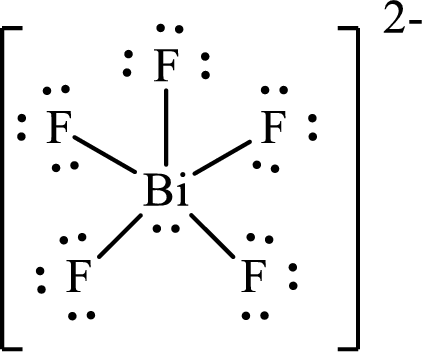
Bismuth forms five single bonds with five fluorine atoms and one lone pair is present on it so six hybrid orbitals are required and therefore the hybridization of bismuth in
The presence of lone pair on the central atom results in the deviation of bond angles from that of the ideal ones.
(e)
Interpretation:
The shape, hybridization of the central atom, ideal and deviated bond angle in
Concept introduction:
Hybridization is the process of intermixing of atomic orbital of slightly different energies to form hybrid orbitals that have similar energy. These orbital have lower energy and more stability than the atomic orbital. Hybridization of the central atom can be determined from the number of electron groups around the central atom in the Lewis structure of the molecule. Single bond, double bond, triple bond and lone pair all are considered as single electron group.
The shape of the molecule is determined by the electron bond pairs and lone pairs that are present around the central atom. The angle between the two bonds is called the bond angle. It is determined by the hybridization of the central atom and the presence of lone pairs around it.
(e)
Answer to Problem 11.38P
In
Explanation of Solution
The Lewis structure of
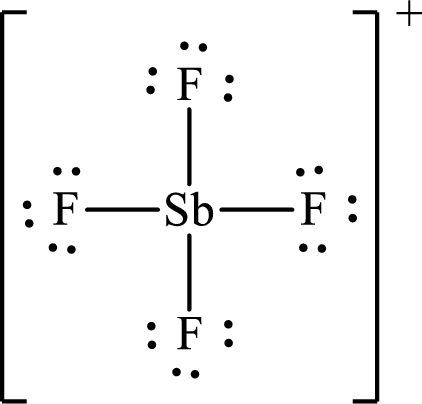
Antimony forms four single bonds with four fluorine atoms so four hybrid orbitals are required and therefore the hybridization of antimony in
The shape of the molecule is determined by the hybridization only if no lone pair is present on the central atom.
(f)
Interpretation:
The shape, hybridization of the central atom, ideal and deviated bond angle in
Concept introduction:
Hybridization is the process of intermixing of atomic orbital of slightly different energies to form hybrid orbitals that have similar energy. These orbital have lower energy and more stability than the atomic orbital. Hybridization of the central atom can be determined from the number of electron groups around the central atom in the Lewis structure of the molecule. Single bond, double bond, triple bond and lone pair all are considered as single electron group.
The shape of the molecule is determined by the electron bond pairs and lone pairs that are present around the central atom. The angle between the two bonds is called the bond angle. It is determined by the hybridization of the central atom and the presence of lone pairs around it.
(f)
Answer to Problem 11.38P
In
Explanation of Solution
The Lewis structure of
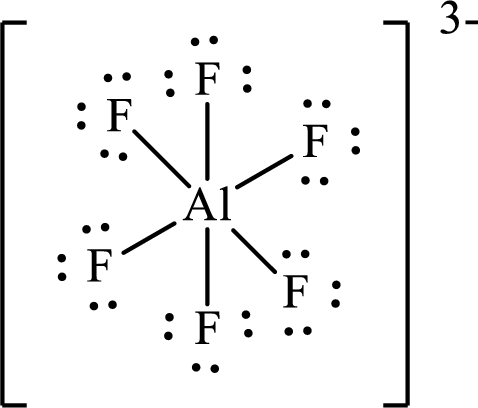
Aluminium forms six single bonds with six fluorine atoms so six hybrid orbitals are required and therefore the hybridization of aluminium in
The shape of the molecule is determined by the hybridization only if no lone pair is present on the central atom.
(g)
Interpretation:
The shape, hybridization of the central atom, ideal and deviated bond angle in
Concept introduction:
Hybridization is the process of intermixing of atomic orbital of slightly different energies to form hybrid orbitals that have similar energy. These orbital have lower energy and more stability than the atomic orbital. Hybridization of the central atom can be determined from the number of electron groups around the central atom in the Lewis structure of the molecule. Single bond, double bond, triple bond and lone pair all are considered as single electron group.
The shape of the molecule is determined by the electron bond pairs and lone pairs that are present around the central atom. The angle between the two bonds is called the bond angle. It is determined by the hybridization of the central atom and the presence of lone pairs around it.
(g)
Answer to Problem 11.38P
In
Explanation of Solution
The Lewis structure of
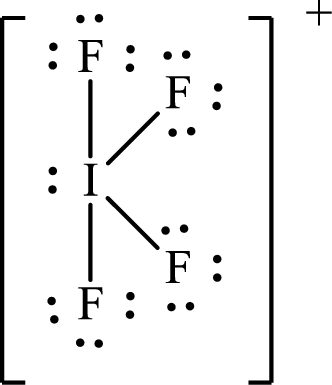
Iodine forms four single bonds with four fluorine atoms and one lone pair is present on it so five hybrid orbitals are required and therefore the hybridization of iodine in
The presence of lone pair on the central atom results in the deviation of bond angles from that of the ideal ones.
Want to see more full solutions like this?
Chapter 11 Solutions
Chemistry: The Molecular Nature of Matter and Change
- . Draw the products for addition reactions (label as major or minor) of the reaction between 2-methyl-2-butene and with following reactants : Steps to follow : A. These are addition reactions you need to break a double bond and make two products if possible. B. As of Markovnikov rule the hydrogen should go to that double bond carbon which has more hydrogen to make stable products or major product. Here is the link for additional help : https://study.com/academy/answer/predict-the-major-and-minor-products-of-2-methyl- 2-butene-with-hbr-as-an-electrophilic-addition-reaction-include-the-intermediate- reactions.html H₂C CH3 H H3C CH3 2-methyl-2-butene CH3 Same structure CH3 IENCESarrow_forwardDraw everything on a piece of paper including every single step and each name provided using carbons less than 3 please.arrow_forwardTopics] [References] Write an acceptable IUPAC name for the compound below. (Only systematic names, not common names are accepted by this question.) Keep the information page open for feedback reference. H The IUPAC name isarrow_forward
- [Review Topics] [References] Write an acceptable IUPAC name for the compound below. (Only systematic names, not common names are accepted by this question.) Keep the information page open for feedback reference. The IUPAC name is Submit Answer Retry Entire Group 9 more group attempts remainingarrow_forwardPlease draw.arrow_forwardA chromatogram with ideal Gaussian bands has tR = 9.0 minutes and w1/2 = 2.0 minutes. Find the number of theoretical plates that are present, and calculate the height of each theoretical plate if the column is 10 centimeters long.arrow_forward
- An open tubular column has an inner diameter of 207 micrometers, and the thickness of the stationary phase on the inner wall is 0.50 micrometers. Unretained solute passes through in 63 seconds and a particular solute emerges at 433 seconds. Find the distribution constant for this solute and find the fraction of time spent in the stationary phase.arrow_forwardConsider a chromatography column in which Vs= Vm/5. Find the retention factor if Kd= 3 and Kd= 30.arrow_forwardTo improve chromatographic separation, you must: Increase the number of theoretical plates on the column. Increase the height of theoretical plates on the column. Increase both the number and height of theoretical plates on the column. Increasing the flow rate of the mobile phase would Increase longitudinal diffusion Increase broadening due to mass transfer Increase broadening due to multiple paths You can improve the separation of components in gas chromatography by: Rasing the temperature of the injection port Rasing the temperature of the column isothermally Rasing the temperature of the column using temperature programming In GC, separation between two different solutes occurs because the solutes have different solubilities in the mobile phase the solutes volatilize at different rates in the injector the solutes spend different amounts of time in the stationary phasearrow_forward
- please draw and example of the following: Show the base pair connection(hydrogen bond) in DNA and RNAarrow_forwardNaming and drawing secondary Write the systematic (IUPAC) name for each of the following organic molecules: CH3 Z structure CH3 CH2 CH2 N-CH3 CH3-CH2-CH2-CH-CH3 NH CH3-CH-CH2-CH2-CH2-CH2-CH2-CH3 Explanation Check ☐ name ☐ 2025 McGraw Hill LLC. All Rights Reserved. Terms of Use | Privacy C Garrow_forwardC This question shows how molecular orbital (MO) theory can be used to understand the chemical properties of elemental oxygen O₂ and its anionic derivative superoxide Oz. a) Draw the MO energy diagram for both O2 and O2. Clearly label your diagram with atomic orbital names and molecular orbital symmetry labels and include electrons. Draw the Lewis structure of O2. How does the MO description of O2 differ from the Lewis structure, and how does this difference relate to the high reactivity and magnetic properties of oxygen? ) Use the MO diagram in (a) to explain the difference in bond length and bond energy between superoxide ion (Oz, 135 pm, 360 kJ/mol) and oxygen (O2, 120.8 pm, 494 kJ/mol).arrow_forward
 ChemistryChemistryISBN:9781305957404Author:Steven S. Zumdahl, Susan A. Zumdahl, Donald J. DeCostePublisher:Cengage Learning
ChemistryChemistryISBN:9781305957404Author:Steven S. Zumdahl, Susan A. Zumdahl, Donald J. DeCostePublisher:Cengage Learning ChemistryChemistryISBN:9781259911156Author:Raymond Chang Dr., Jason Overby ProfessorPublisher:McGraw-Hill Education
ChemistryChemistryISBN:9781259911156Author:Raymond Chang Dr., Jason Overby ProfessorPublisher:McGraw-Hill Education Principles of Instrumental AnalysisChemistryISBN:9781305577213Author:Douglas A. Skoog, F. James Holler, Stanley R. CrouchPublisher:Cengage Learning
Principles of Instrumental AnalysisChemistryISBN:9781305577213Author:Douglas A. Skoog, F. James Holler, Stanley R. CrouchPublisher:Cengage Learning Organic ChemistryChemistryISBN:9780078021558Author:Janice Gorzynski Smith Dr.Publisher:McGraw-Hill Education
Organic ChemistryChemistryISBN:9780078021558Author:Janice Gorzynski Smith Dr.Publisher:McGraw-Hill Education Chemistry: Principles and ReactionsChemistryISBN:9781305079373Author:William L. Masterton, Cecile N. HurleyPublisher:Cengage Learning
Chemistry: Principles and ReactionsChemistryISBN:9781305079373Author:William L. Masterton, Cecile N. HurleyPublisher:Cengage Learning Elementary Principles of Chemical Processes, Bind...ChemistryISBN:9781118431221Author:Richard M. Felder, Ronald W. Rousseau, Lisa G. BullardPublisher:WILEY
Elementary Principles of Chemical Processes, Bind...ChemistryISBN:9781118431221Author:Richard M. Felder, Ronald W. Rousseau, Lisa G. BullardPublisher:WILEY





